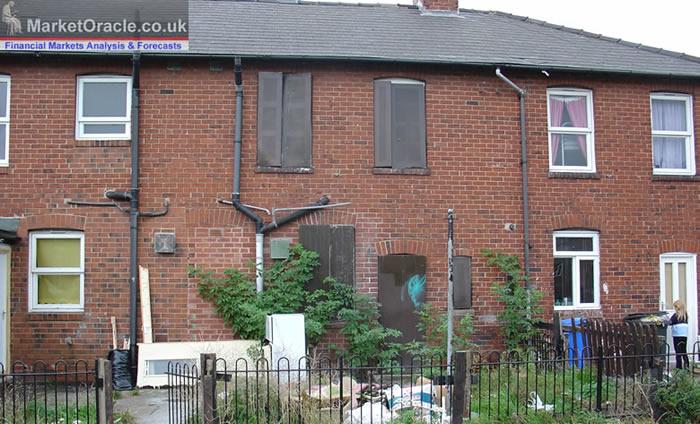UK Buy to Let Property Investing Business Top 12 Tips
Housing-Market / Buy to Let May 24, 2014 - 01:54 PM GMTBy: Nadeem_Walayat
 Investing in buy to let properties is nothing new for this is a near 3 decades old trend that began as a consequence of the Thatcher government introducing the policy of selling off council houses that continues to this day despite the emergence of the housing associations sector, today private rental properties out number social housing with some 10 million people in private rental properties more than triple the number 20 years ago as rising property prices and cost of living is pushing home ownership out of the reach of those on average earnings.
Investing in buy to let properties is nothing new for this is a near 3 decades old trend that began as a consequence of the Thatcher government introducing the policy of selling off council houses that continues to this day despite the emergence of the housing associations sector, today private rental properties out number social housing with some 10 million people in private rental properties more than triple the number 20 years ago as rising property prices and cost of living is pushing home ownership out of the reach of those on average earnings.
It is not surprising that many people continue to be tempted into investing their hard earned cash into the always in demand buy to let sector when one considers the alternatives to long-term income generating bricks and mortar investments when compared to the likes of the pensions industry that time and time again has shown itself to be nothing more than a SCAM where retiree's end up being in receipt of a mere fraction of the pensions that the sales men promised several decades earlier.
Then there are the self invested personal pension schemes are SIPPS which whilst not being a scam are NOT suitable for 90% of investors because stock market investing is HIGH RISK and should never comprise more than 10% of assets for most investors and therefore does into tally with low risk retirement pensions planning.
The other alternatives are cash and government bonds, which over the long-run will not be able to keep pace with inflation let alone generate a real terms return.
Therefore buy to let for several decades has seemed like the obvious destination for ordinary people attempting to invest for their retirement.
However, those contemplating entering the buy to let sector for the first time will need to prepare themselves for a steep learning curve and understand that they will have to invest a lot of their time and effort to make it work. In fact if you are considering for instance having 3 or more properties then really you should be approaching buy to let as a business that will demand input of several hours per day to deal with the multitude of issues that will tend to crop up.
My Top 12 Buy to Let Tips
1. Start small, don't invest all of your capital into one property in case it is not for you and you are forced to exit at a loss. So for your first property look for something that is not too old that may require a lot more work before putting onto the rental market as well as ongoing maintenance.
2. Buy to Let mortgages tend to carry higher interest rates and fees so it may be better to initially utilise equity in your home.
3. Don't over leverage yourself i.e. in terms of mortgage relative to equity, consider what the implications are if your buy to let mortgage interest rate doubles, will the rental income still cover all of the costs? My suggestion is aim for properties that will yield a rental income of 7% of the cost of the property.
4. Buy to let is a taxable business, you need to be aware of all of the taxes that you will be liable for such as income tax, and capital gains. However expenses incurred including mortgage interest are allowable expenses to set against income when calculating taxable profits.
5. Remember you are buying to let and not to live in so think in terms of what is in demand in the area. For instance a 1 bed flat or 2 bed house may prove a much better investment than a 4 bed family house, despite the fact that you may personally prefer the 4 bedroom house which in demand terms comprises only 5% of the rental market against 36% for 2 bed, and 30% for 3 bed.
So do your research and remember that people looking to rent tend to go for smaller properties then those buying so focus on properties that appeal to the most number of potential tenants in established buy to let areas rather than run down slums.
6. When viewing don't fall in love with the property, have a price in mind and make the offer and then be prepared to walk away if the offer is not accepted.
7. Consider using a letting agent to manage your property as they can take most of the work load off your back allowing you time to learn and concentrate on expanding your property portfolio rather than on finding and chasing tenants for payments and on maintenance. Understand that the agent will typically charge a fee of between 7%-15% of the rent. Make sure you are clear on what is or is not included in the fee as bad letting agents can have a whole host of add on fees such as for arranging maintenance.
Also be aware that the letting agent will be less picky than you about the quality of tenant that they put into your property, so you are more likely to end up with a bad tenant with the associated consequences.
8. The worst times are when properties are empty which means that you have to pay all of the bills as well as any mortgage repayments without an covering income. So when you get a good tenant hold onto them by ensuring that you act quickly on any maintenance requests.
9. Your property will need to meet a constantly expanding list of legal requirements which will cost money, as well as landlords insurance on top. The risk here is of an accident attributable to a failure to meet a requirement that can result in severe penalties and prosecution. This can only get worse over time as more and more people are forced to rent so the politicians will be more likely to bribe them with private renter friendly policies.
10. Don't renovate properties to a poor / average standard, it is better to go a little extra so that the property appeals to a better class of hard working tenant who is likely to be a more reliable tenant.
11. Avoid housing benefit tenants, whilst most may be fine, however it is just not worth the risk with a small portfolio of properties to be lumbered with a tenant from hell which in my experience are three times more likely to be housing benefit claimants than private, and should they wreck your property then they are unlikely to have assets / income to pursue them through the courts to recover the costs of damages.

Again it is just not worth the risk of ending up with a bad tenant who you have to go through the costly and lengthy process of evicting, though insurance can be purchased to cover the legal costs. The universal credit housing benefit changes have made things even worse as now housing benefit is paid direct to the tenant rather than the landlord which increases the probability of arrears.
12. Open a separate bank account for your buy to let business so that you can more easily account for income and expenditure. If your buy to let empire starts to expand then look at turning it into a more tax efficient limited company.
The bottom line is to approach buy to let investing with your eyes open and understand that at the very least it should be treated as part-time job that demands several hours of work per week. And understand that the more successful you become then the more you will become hated by your renting friends and family who will come to see you as the reason why they cannot buy a house, a situation that can only get worse as the private rental sector continues to grow.
The above is just a small excerpt from the What Can You Afford to Buy? section of the New UK Housing Market Ebook available for FREE DOWNLOAD (Only requirement is a valid email address).
| Page | |
| Part 3: Housing Market Guides |
135 |
| What Can You Afford to Buy? | 135 |
| Help to Buy Caution | 136 |
| House Buying or Renting Scenarios | 136 |
| Home Buying Profit and Loss Calculator | 138 |
| Buy to Let Property Investing / Business | 138 |
| Top 12 Buy to Let Tips | 139 |
| Home Ownership and Debt & Mortgages | 140 |
| Mortgage Debt and the Risk of Ruin | 141 |
| Debt is Slavery | 141 |
| The Circle of Slavery - Past, Present and Future | 142 |
| Debt Free Freedom? | 143 |
| House Price Inflation is the Ultimate Mechanism for Slavery | 143 |
| The Real Secret to Financial Success | 144 |
| Mortgages - Debt Till Death literally! | 146 |
| Debt Conclusion | 146 |
 New Housing Market Ebook - FREE DOWNLOAD
New Housing Market Ebook - FREE DOWNLOAD
The housing market ebook of over 300 pages comprises four main parts :
1. U.S. Housing Market Analysis and Trend Forecast 2013-2016 - 27 pages
The US housing market analysis and concluding trend forecast at the start of 2013 acted as a good lead exercise for the subsequent more in-depth analysis of the UK housing market.
2. U.K. Housing Market Analysis and House Prices Forecast 2014-2018 - 107 pages
The second part comprises the bulk of analysis that concludes in several detailed trend forecasts including that for UK house prices from 2014 to 2018 and their implications for the outcome of the next General Election (May 2015) as well as the Scottish Referendum.
3. Housing Market Guides - 138 Pages
Over 1/3rd of the ebook comprises of extensive guides that cover virtually every aspect of the process of buying, selling and owning properties, including many value increasing home improvements continuing on in how to save on running and repair costs with timely maintenance tasks and even guides on which value losing home improvements should be avoided.
- What Can You Afford to Buy?
- Home Buyers Guide
- Home Sellers Guide
- Top 15 Value Increasing Home Improvements
- Home Improvements to Avoid
- Home Winter Weather Proofing 22 Point Survey

These guides will further be supplemented from Mid 2014 onwards by a series of online videos and regularly updated calculators such as the Home Buying Profit and Loss Calculator, which will seek to give calculations on whether to buy or rent based on personal individual circumstances, that will be updated to include the latest expected trend trajectories for future house price inflation i.e. you will have your own personal house price forecast.
4. Historic Analysis 2007 to 2012 - 40 pages
A selection of 10 historic articles of analysis to illustrate the process of analysis during key stages of the housing markets trend from the euphoric bubble high, to a state of denial as house prices entered a literal free fall, to the depths of depression and then emergence of the embryonic bull market during 2012 that gave birth to the bull market proper of 2013.
FREE DOWNLOAD (Only requirement is a valid email address)
Source and comments: http://www.marketoracle.co.uk/Article45744.html
By Nadeem Walayat
Copyright © 2005-2014 Marketoracle.co.uk (Market Oracle Ltd). All rights reserved.
Nadeem Walayat has over 25 years experience of trading derivatives, portfolio management and analysing the financial markets, including one of few who both anticipated and Beat the 1987 Crash. Nadeem's forward looking analysis focuses on UK inflation, economy, interest rates and housing market. He is the author of five ebook's in the The Inflation Mega-Trend and Stocks Stealth Bull Market series that can be downloaded for Free.
 Nadeem is the Editor of The Market Oracle, a FREE Daily Financial Markets Analysis & Forecasting online publication that presents in-depth analysis from over 1000 experienced analysts on a range of views of the probable direction of the financial markets, thus enabling our readers to arrive at an informed opinion on future market direction. http://www.marketoracle.co.uk
Nadeem is the Editor of The Market Oracle, a FREE Daily Financial Markets Analysis & Forecasting online publication that presents in-depth analysis from over 1000 experienced analysts on a range of views of the probable direction of the financial markets, thus enabling our readers to arrive at an informed opinion on future market direction. http://www.marketoracle.co.uk
Disclaimer: The above is a matter of opinion provided for general information purposes only and is not intended as investment advice. Information and analysis above are derived from sources and utilising methods believed to be reliable, but we cannot accept responsibility for any trading losses you may incur as a result of this analysis. Individuals should consult with their personal financial advisors before engaging in any trading activities.
Nadeem Walayat Archive |
© 2005-2022 http://www.MarketOracle.co.uk - The Market Oracle is a FREE Daily Financial Markets Analysis & Forecasting online publication.








